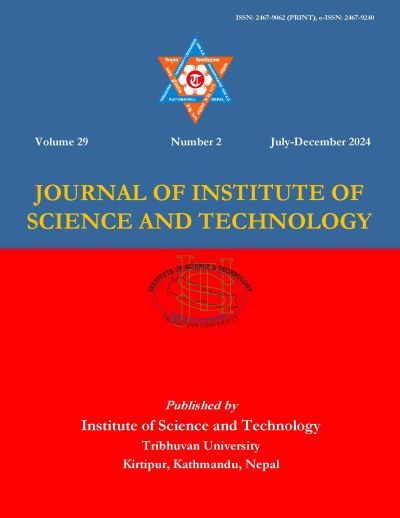Hyperparasitism by Viscum monoicum Roxb. ex DC. on Dendrophthoe falcata (L.F.) Ettingsh: A Novel Case Reported from Nepal
DOI:
https://doi.org/10.3126/jist.v29i2.67562Keywords:
Dendrophthoe falcata, hyperparasitism, Nepal, Viscum monoicumAbstract
A rare occurrence of Viscum monoicum Roxb. ex DC. (Viscaceae) on Dendrophthoe falcata (L.F.) Ettingsh. (Loranthaceae) has been reported as a novel case of incidental hyperparasitism for the first time from the tropical forests of Nepal.
Downloads
References
Barlow, B. (2011). Epiparasitism – mistletoes on mistletoes. Mistletoes in Australia. Retrieved June 05, 2024 from https://www.anbg.gov.au/mistletoe/epiparasitism.html.
Danser, B.H. (1941). Miscellaneous notes on Loranthaceae. Blumea, 4, 295˗319.
Devkota, M.P., & Glatzel, G. (2005). Mistletoes of Annapurna Conservation Area, Central Nepal Himalayas. Journal of Japanese Botany, 80, 27˗36.
Hawksworth, F.G., & Wiens, D. (1996). Dwarf mistletoe: Biology, pathology and systematics. Agricultural Handbook 709. USDA, Washington DC.
Pundir, Y.P.S. (1979). A case of spectacular hyperparasitism in mistletoes. Indian Journal of Forestry, 2(4), 303˗306.
Pundir, Y.P.S. (1981). A note on the biological control of Scurrula cordifolia (wall.) G. Don by another mistletoe in Shivalik Hills (India). Weed Research, 21, 233˗234.
Pundir, Y.P.S. (1989). Studies on the mistletoes of Dehra Dun valley and adjacent places – I. Viscum loranthii: distribution, germination, host specificity and interaction with the host. Indian Journal of Forestry, 12(1), 36˗39.
Pundir, Y.P.S., Purohit, M.C., & Kimothi, P. (1994). Heterogenous, hyper and triple-parasitism among mistletoes. World Weed, 1, 117˗121.
Rao, R.S. (1957). A revision of Indo-Malayan species of Viscum Linn. Journal of Indian Botanical Society, 36(2), 113˗168.
Tennakoon, K.U., Chak, W.H., Lim, B.L., & Bolin, J.F. (2014). Mineral nutrition of the hyperparasitic mistletoe Viscum articulatum Burm. f. (Viscaceae) in tropical Brunei Darussalam. Plant Species Biology, 29, 101–107.
Thriveni, M.C., Shivamurthy, G.R., Amruthesh, K.N., Vijay, C.R., & Kavitha, G.R. (2010). Mistletoes and their hosts in Karnataka. Journal of American Science, 6(10), 827˗835.
Visser, J. (1981). South African parasitic flowering plants. Juta and Co., Limited, Johannesburg.
Weeraratna, W.G. (1960). Ecology and biology of parasitism of the Loranthaceae of Ceylon. Ceylon Forestry, 4(3), 264˗280.
Wiens, D., & Calvin, C.L. (1987). Epiparasitism in mistletoes. Golden Bough (Royal Botanic Gardens, Kew), 9, 3˗5.
Wiens, D., & Calvin, C. (2011). Two epiparasitic species of Phoradendron (Viscaceae) from Honduras: One new and for the other a range extension and host determination. Aliso, 29(2), 119˗123.
Wilson, C.A., & Calvin, C.L. (2017), Metadata provide insights on patterns of epiparasitism in mistletoes (Santalales), an overlooked topic in forest biology. Botany, 95, 259–269.
Downloads
Published
How to Cite
Issue
Section
License
Copyright (c) 2024 Institute of Science and Technology, T.U.

This work is licensed under a Creative Commons Attribution-NonCommercial 4.0 International License.
The views and interpretations in this journal are those of the author(s). They are not attributable to the Institute of Science and Technology, T.U. and do not imply the expression of any opinion concerning the legal status of any country, territory, city, area of its authorities, or concerning the delimitation of its frontiers of boundaries.
The copyright of the articles is held by the Institute of Science and Technology, T.U.




